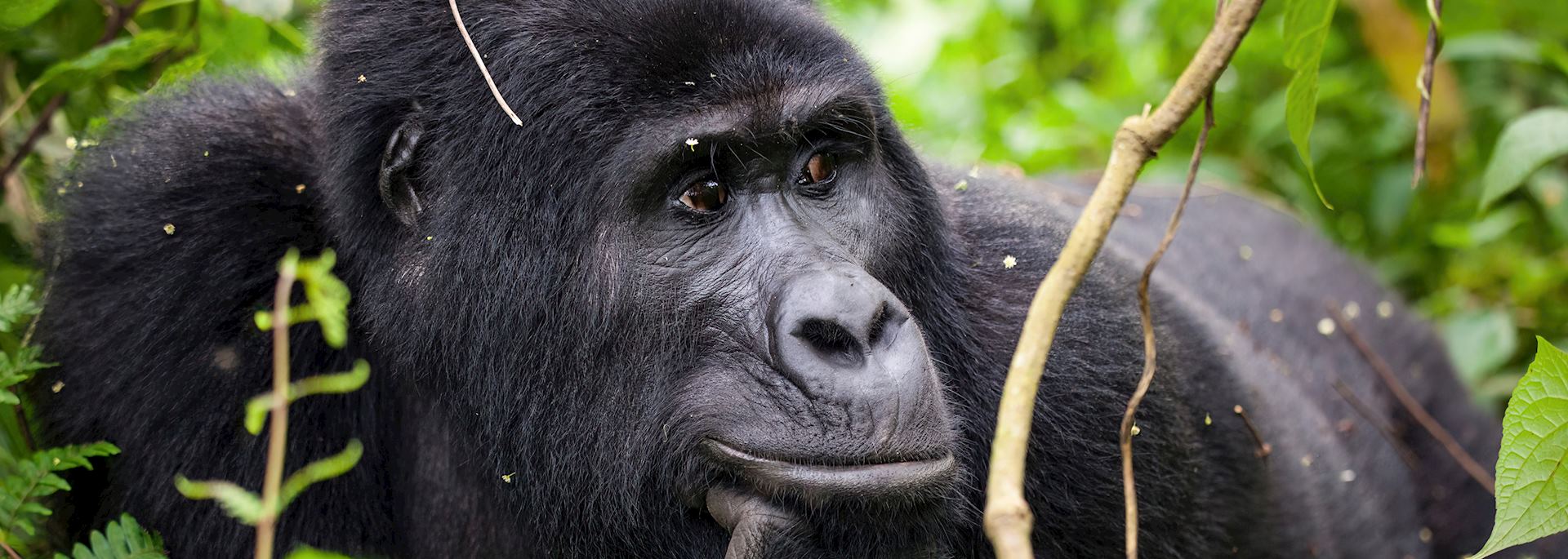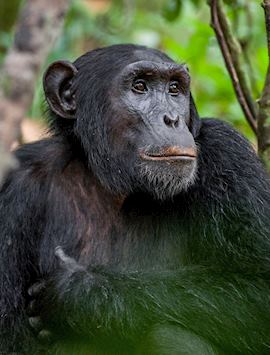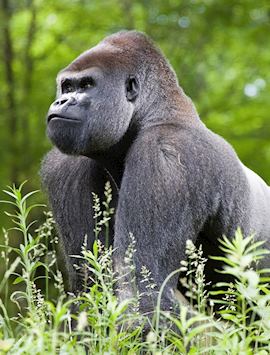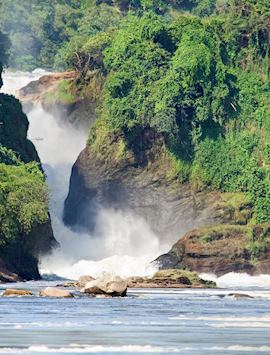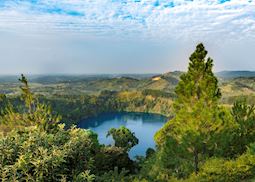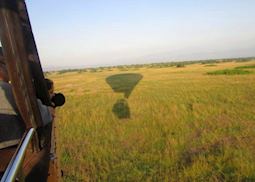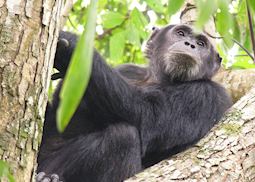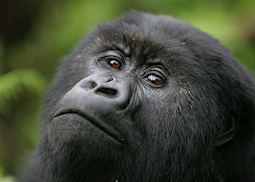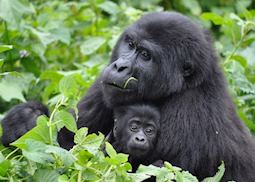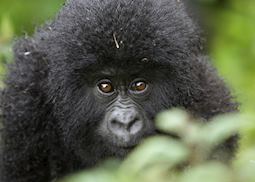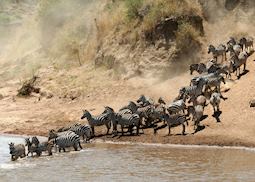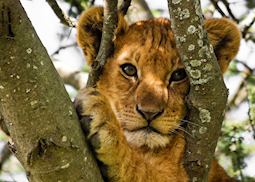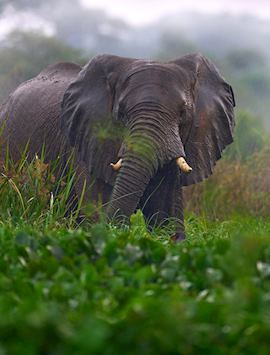
Uganda is a welcome splash of green in a predominantly arid continent. Its dense forests give shelter to some of the last remaining mountain gorillas on Earth. People travel from far and wide to spend an hour in their presence, watching them graze, groom, sleep and play. Our safari specialists, having experienced the country beyond its prized wildlife attraction, will arrange your gorilla encounter and recommend how to spend your vacation in Uganda before or after.
We can arrange a safari in Queen Elizabeth National Park, giving you a chance to see the Big Five, including tree-climbing lion. On boat trips along the Ishasha River, you can look for water-dwelling birdlife, hippo pods and elephant herds lining the banks. Or, trek with a guide through Kibale Forest National Park for a chance to see its 13 species of primate, including chimpanzees, red colobus and L’Hoest’s monkeys, and grey-cheeked mangabeys.
Suggested tours for Uganda
These tours give you a starting point for what your vacation to Uganda could entail. Treat them as inspiration, as each trip is created uniquely for you.
Suggested activities for Uganda
Whatever your interests, our specialists will build activities into your trip that connect to how you want to experience Uganda.
-
Chimpanzee Tracking in Kibale Forest ![Ngamba Island Chimpanzee Sanctuary, Uganda]()
Chimpanzee Tracking in Kibale Forest
Kibale Forest National ParkChimpanzee Tracking in Kibale Forest
You enter the forest and following signs and chimp calls your guide leads you to the chimpanzees. Chimpanzee sightings are not guaranteed, however the odds of encountering them have greatly increased in recent years, now standing at 90% or over.
View details -
Exploring the Crater Lakes Region ![Crater Lakes Region, Uganda]()
Exploring the Crater Lakes Region
Kibale Forest National ParkExploring the Crater Lakes Region
This area is characterized by rolling hills, vanilla plantations, pretty forests and of course the Crater Lakes. For some of the Crater Lakes, the views are actually best from the viewpoints, accessed by roads.
View details -
Hot air balloon flight ![Hot air ballooning, Queen Elizabeth National Park]()
Hot air balloon flight
Queen Elizabeth National ParkHot air balloon flight
Ballooning has long been popular in East Africa for wildlife viewing and taking in the majesty of the environment. An early start is unavoidable but the morning wake-up call will soon be forgotten as you float over the bush below, spotting animals from the air.
View details
More choice for your safari
- Inspiration across all our African destinations
- Trip suggestions based on your interests
- Advice on where to safari, when
- Meet our team of safari experts
Best time to visit
Our specialists advise on the best months to visit Uganda, including information about climate, events and festivals.
Request our brochure
Covering all seven continents, The World Your Way shows you how you can see the world with us. It features trip ideas from our specialists alongside hand-picked stays and experiences, and introduces our approach to creating meaningful travel experiences.
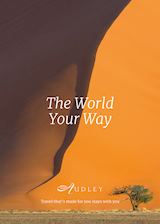
Useful information for planning your vacation in Uganda
English is the official language of Uganda and taught in all schools. However, most Ugandans speak English as a second language. There are more than 33 local languages spoken across the country, but almost everybody you’ll meet will be able to speak some English.
The currency in Uganda is the Ugandan shilling (Ush or UGX). US dollars are also widely accepted. There are very few ATMs in Uganda and although credit cards are accepted at some of the major hotels, a 5-10% surcharge will usually be added. We recommend that you don’t rely on credit cards other than as a back-up.
Hotels will accept payment for food, drinks, and tips in dollars or shillings. You should only need shillings for occasional drinks in roadside stops, lunches in local restaurants, and souvenirs, although most do accept US dollars in low denominations.
In Uganda you should try luwombo, a local stew of beef, chicken, or fish, mixed with vegetables and steamed in a plantain leaf. Stews are served with one of four staples: rice, chapati, ugali (a stiff maize porridge), or matoke (a mash of steamed green bananas). You’ll also find many dishes cooked with a groundnut sauce.
Camps, hotels, and lodges generally serve an international menu.
For the latest travel advice for Uganda, including entry requirements, health information, and the safety and security situation, please refer to the .
In Uganda you can hike through dense forest to track mountain gorillas, see elephant, buffalo, lion, and leopard on safari, or watch the Nile force its way through a narrow gorge at Murchinson Falls. Most visitors come to Uganda to see the world’s last remaining mountain gorillas, and the challenging hike through the mountains on the trail of these great apes is a highlight of a trip. However, Uganda also offers rewarding safaris by 4x4, boat, and on foot in its national parks and wildlife reserves and you can expect to see rare tree-climbing lion, hippo, elephant, and a wide variety of primates.
In Uganda you can stay in small lodges and tented safari camps, or urban guesthouses and hotels. The choice of places to stay here isn’t as varied as in some other destinations, and in some places can be quite limited, but our specialists have chosen a variety of comfortable options with good standards of food and service.
You could stay in luxurious stone cottages while tracking gorillas, thatched cottages overlooking the grassy plains of Queen Elizabeth National Park, or in safari lodges in Murchison Falls National Park. For more ideas, browse our collection of places to stay in Uganda to start planning your trip.
Most visitors to Uganda go to Bwindi Impenetrable Forest, Queen Elizabeth National Park, and Murchinson Falls National Park.
One of the most biologically diverse forests in Africa, Bwindi Impenetrable Forest is home to more than half the world's population of mountain gorillas, and tracking the troops through the dense forest is a tough but rewarding adventure. By contrast, the wide savannah plains of Queen Elizabeth National Park are home to lion, hippo, buffalo, hyena, and crocodiles, while Murchinson Falls National Park offers sightings of a wide variety of wildlife where the Nile surges through a cleft in the Rift Valley escarpment.
Although mountain gorillas are the main draw in Uganda, you’ll also get the chance to see most of the Big Five, including lion, elephant, buffalo, and leopard. Rare tree-climbing lion can also be seen, and on boat trips along the Ishasha River, hippo wallow in the water and elephant line the banks. Kibale Forest National Park is home to 13 species of primate, including chimpanzees, red colobus and L’Hoest’s monkeys, and grey-cheeked mangabeys, while the birdlife at Murchinson Falls includes over 460 species.
It takes around 14 and a half hours to fly from Toronto to Uganda.
The time zone in Uganda is UTC+3 hours. Daylight Savings Time is not observed.
The best way of getting around southern Uganda is by road as the distances are relatively small and the scenery a highlight. For travel in northern Uganda and for visits to Murchison Falls, we recommend taking a light aircraft, particularly during the wet seasons.
Use our travel tool to find up-to-date visa and passport requirements for Uganda. Enter where you’re traveling to and from (including any stopover destinations en route or flight layovers), along with your intended travel dates and passport details, for a full list of requirements.
Your doctor can provide you with immunization advice for Uganda, but you should also ensure you’re up to date with the recommended vaccinations for your home country. You can also check the recommended vaccinations by visiting the .
Malaria is a risk throughout Uganda. Please see your doctor for advice about which antimalarial medication you should take.
You can reduce your risk of contracting malaria by avoiding being bitten by mosquitoes. Wear long, loose clothing, use insect repellent, and use mosquito nets where provided.
You must be 15 years or older to track gorillas in Uganda. Tracking the troops requires hiking through dense forest on steep mountainsides and is not suitable for children under 15.
Gorilla tracking in Uganda begins early in the morning when trackers scout the forest for clues to the gorillas’ location. Your guide will then take you onto the mountain paths in the direction of where the troop was last seen. Depending on where the gorillas are located, the hike can take anywhere from half an hour to several hours with your guide pointing out evidence of gorilla activity as you go.
As you approach the gorillas’ location you may hear grunts or grumbles, or see movement in the trees ahead, but nothing quite prepares you for your first sight of the troop, sitting on the ground or climbing among the trees. Their facial gestures and human-like hands are so similar to our own that just being in their presence and knowing how threatened they are feels like an enormous privilege.
You’ll get to spend an hour observing the gorillas as they munch on leaves, strip bark, groom each other, or cuddle infants. Visits are kept short, and you’ll need to keep a certain distance away to avoid causing the apes distress and to prevent disease transmission.
Sitting in a hushed group observing the gorillas, you’ll be close enough to take photographs, witness the charismatic interactions between troop members, and discern the intelligence, delight, or concern on their faces. Infants cling to mother’s backs, silverbacks lord over the scene, and others chew on bamboo shoots as if unaware of the human presence. For most visitors, the hour with these gentle giants leaves them smitten and very aware of the extraordinary connection we have with these apes and the fragility of the ecosystems that support them.
Wear long trousers, good walking boots, and gloves when tracking gorillas in Uganda. The forest is dense here and trousers will protect you from scratches and insect bites, while a pair of gloves are handy to help steady yourself on branches along the slippery mud trails. A pair of walking poles can also be helpful as you might encounter steep ascents and descents on the mountain slopes.
Uganda in pictures
Our expert guides to traveling in Uganda
Written by our specialists from the viewpoint of their own travels, these guides will help you decide on the shape of your own trip to Uganda. Aiming to inspire and inform, we share our recommendations for how to appreciate Uganda at its best.
-
![My travels in Uganda]()
My travels in Uganda, 2018
Getting close to buffalo, elephant and birdlife on boat trips, watching cave-dwelling Egyptian fruit bats, and getting to know the traditions of rural tribes — a trip to Uganda can take you beyond gorilla tracking. Safari specialist Mark shares footage from his latest visit.
-
Chimpanzee trekking vacations in Africa ![Chimpanzee, Mahale Mountains National Park]()
Chimpanzee trekking vacations in Africa
Chimpanzee trekking vacations in Africa
Africa's most famous primates are its gorillas but there are places which reverberate to the hoots and shrieks of their closest relatives, chimpanzees. Discover more about Audley tailor-made trips to see wild chimpanzees.
Read this guide -
Gorilla tracking: Rwanda or Uganda? ![Mountain gorilla, Volcanoes National Park]()
Gorilla tracking: Rwanda or Uganda?
Gorilla tracking: Rwanda or Uganda?
Tracking mountain gorilla in either Uganda or Rwanda is one of Africa's most memorable wildlife encounters. There are pros and cons to each country, but in each one, you will have an experience you will never forget.
Read this guide -
What to do in Uganda: our highlights guide ![Mother and baby gorilla]()
What to do in Uganda: our highlights guide
What to do in Uganda: our highlights guide
Uganda is famed for its mountain gorillas, and tracking them through the forest with a guide is one of the world’s greatest wildlife experiences. Africa specialist Toby describes how to encounter Uganda’s gorillas and more of its wildlife, from chimpanzees to tree-climbing lion.
Read this guide
Other popular destinations
Still looking for ideas? If Uganda has captured your interest, we think you might also like these destinations.
